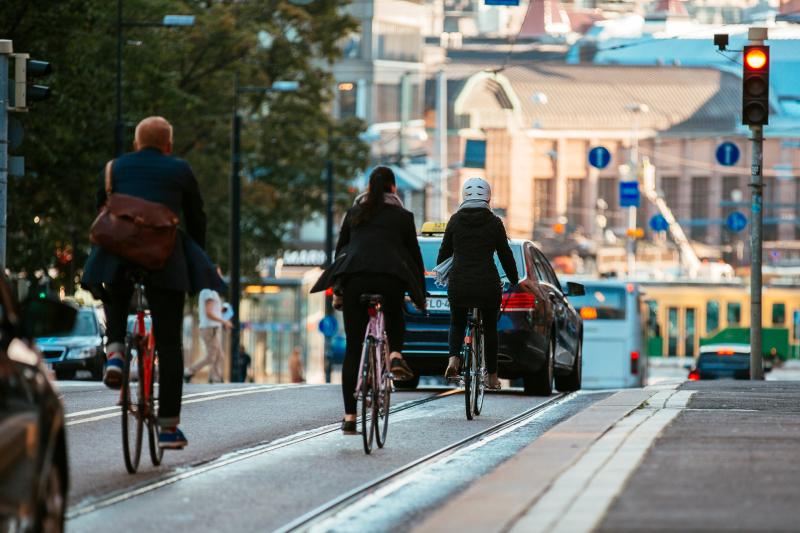News about city planning
A big leap forward in climate work
Helsinki's greenhouse gas emissions have recently decreased by a record amount. In two years (2021–2023), Helsinki’s direct CO2 emissions decreased by 17 per cent.
The record figures are mainly due to the closure of the Hanasaari coal-fired power plant. The closure of the power plant was possible because the City's energy company, Helen, has made and continues to make substantial investments in low-emission energy production.
Heating is still the largest source of direct emissions in Helsinki, and electricity is the third largest. According to forecasts, the situation is changing: traffic will become the largest source of emissions in Helsinki in 2025. In 2021–2023, traffic emissions decreased by four per cent.
As part of the Carbon-neutral Helsinki programme, we are investigating what kinds of traffic reforms could be implemented in Helsinki in order to reduce traffic emissions faster than at present. The Helsinki Urban Environment committee will discuss the results of the analysis in the autumn.
Helsinki’s total CO2 emissions have now decreased by 45 per cent from the reference year 1990. Per capita emissions have decreased by 60 per cent over the same period. By 2030, Helsinki aims to achieve a 100 per cent reduction in emissions compared to the reference year – if necessary, by using emission compensation measures.

Regional plan to be specified
The joint plan of the municipalities in the Helsinki region for land use, housing and traffic (MAL 2023) was approved last autumn. The vision is to develop the Helsinki region into the most sustainably growing and humane metropolitan area in Europe by 2040.
The Government Programme and the MAL 2023 plan serve as the basis for the MAL agreement between the state and municipalities. It lays down the most important regional measures and the state’s contribution to them. This year, the MAL measures will be updated for 2024–2027. The items to be negotiated include the financial base of the Vantaa tram line and many other key projects in the Helsinki region, among other things.
7,000 new homes each year
In the next few years, Helsinki seeks to build 7,000 new housing units per year. The plan is to set this as the target in the new implementation programme for housing and land use, which the City Council will decide on in August.
The programme will outline the guidelines for housing construction in Helsinki for the next four years. The aim is to diversify the housing stock throughout the Helsinki area.
According to the draft programme, improvements to residential areas and urban infill will be implemented in, for example, suburban regeneration areas. These areas include Malminkartano, Kannelmäki, Malmi, Mellunkylä and Meri-Rastila.
The updated programme takes into account the change in the potential of housing construction, which has been impacted by the economic situation. The current production target is 8,000 housing units per year, but the amount of production will remain at a more moderate level than in peak years at least this year and the next. In 2023, almost 8,200 housing units were completed in Helsinki, but construction only began on 5,000 housing units.
One major change is Helsinki’s aim to replace the Hitas system with new solutions. Solutions such as a ‘rent-to-buy’ model will be developed to replace Hitas.
The City will also continue looking into other housing models suitable for Helsinki. The current Government Programme puts additional pressure on these efforts, as it provides that the state will no longer grant support for the construction of new right-of-occupancy housing. This is a major change with regard to Helsinki’s housing production.
More nature reserves in Helsinki
By 2040, at least 10 per cent of the area of Helsinki will be converted into protected land and sea areas. This objective is included in Helsinki’s environmental protection objectives, which were approved by the City Board this spring.
Each year, at least five new nature reserves are established in Helsinki in order to protect biodiversity. This year, Helsinki is preparing to establish three new nature reserves in the Mustavuori area, north of Vuosaari. Nature reserves are also being planned in southern Vuosaari and Tali in western Helsinki.
Forests will be managed more naturally
Helsinki’s guidelines for nature management are being updated. The first to have been completed are the principles that guide forest management. Forest biodiversity will be systematically increased and forest areas will be left to age naturally more than before. The management of the City's forests will continue to have no financial profit targets.
The nature management guidelines for meadows, as well as the work instructions for nature management, will be updated next.
The land area of Helsinki is approximately 35 per cent forest, and the total wooded area is 42 per cent. According to a recent survey, the total number of trees and forests in the city has not substantially changed over the past ten years.
Reconciling the growth of the city with the preservation of the local nature still requires active work. The environmental protection objectives have stated that construction in green areas will be avoided. In the future, if construction is planned for green areas, it must be compensated for by improving the ecological quality of green areas, restoring natural sites or creating new local green environments, for example.
